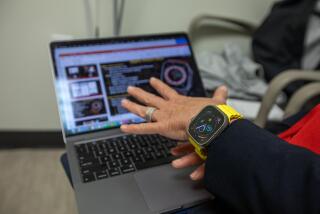Cardiac Complications : HEART FAILURE: A Critical Inquiry Into the Revolution in Heart Care, <i> by Thomas J. Moore (Random House: $19.95; 320 pp.; 0-394-56958-X) </i>
- Share via
Advances in the understanding and treatment of cardiovascular disease have been dramatic and widely chronicled in the last two decades. Armed with a more precise understanding of the events triggering a heart attack, cardiologists now can administer potent clot-dissolving agents to abort the attack. Technological breakthroughs in X-ray equipment and catheter design allow physicians not only to precisely identify cholesterol deposits in coronary arteries but also to treat the plaque non-surgically with devices that expand, vaporize, scrap and pulverize the deposits. Cardiac surgeons have ascended the therapeutic pedestal for the wondrous reconstructive surgery that can be performed on the heart--from the now commonplace coronary-bypass grafting to more challenging, exotic operations such as heart and lung transplantation, repair of birth defects and surgical treatment of electrical abnormalities of the heart.
This rapid and heady growth has not occurred without its critics. Thomas Moore, an investigative journalist, joins the ranks of those who would question the uncritical acceptance of these advances in his provocative and unsettling “Heart Failure: A Critical Inquiry Into the Revolution in Heart Care.”
Moore acknowledges and is appreciative of the gains that have been made in treating heart disease. But his task is not to heap praise on the pioneers of balloon angioplasty or bypass surgery but to address the most controversial and frequently painful questions surrounding the advances in cardiac care. Does available scientific data support the massive government-led campaign to identify and treat those individuals with elevated cholesterol levels? What accounts for the widely differing mortality rates among cardiac surgeons, and what is a prospective bypass patient to make of these disparities? Can the public trust physicians to police themselves and assure quality of care?
The complexity of these issues is monumental, and an effort to make them accessible to the lay and medical audience alike is laudable. However, to try and identify truths in this morass can be as challenging as the Gordian knot is fast. Moore has set no easy task for himself and attacks an array of mighty monoliths. Cholesterol is becoming a watchword of our time--the topic of best-selling books, on the cover of national magazines, and a tidbit of medical data that all patients seem to know. Interest in cholesterol levels may replace astrological signs as a conversation opener at cocktail parties. Is all this excitement about cholesterol warranted?
Moore takes to task a government panel of health experts for a seemingly biased interpretation of large-scale clinical trials addressing the importance of elevated blood cholesterol. Despite the drop in rates of coronary heart disease achieved by lowering blood cholesterol, there has been no difference in overall mortality between treated and untreated groups. Those individuals in the treated group had a higher rate of violent deaths (accidents and suicides) that canceled the benefit of lowering the rate of heart disease.
The author teases apart the threads of the cholesterol story in great detail. Sedulous research of an impressive number of scientific articles obviously has gone into his account, and in learning of the way in which clinical trials are implemented and interpreted, he has discovered their strengths and weaknesses. Much of medical progress justifiably rests on the results of the randomized clinical trial. Yet, it is an imperfect tool, and because of an overwhelming number of uncontrollable variables, it does not lend itself to the unambiguous conclusions that can be reached by the basic laboratory scientist. The national campaign to identify and treat those with elevated cholesterol levels rests on trials that Moore finds not only lacking in scientific proof but potentially leading to a conflict of interest. According to the author, the cholesterol-education program promulgated by medicine and industry “. . . was not exactly a public-service campaign but a business scheme to sell physician’s services and other products.”
If the reader is hoping for prescriptions, Moore does not proffer them. His efforts are confined to exposing the roots of the controversy. In respect to cholesterol lowering, we are left with the less-than-encouraging prospect that, in the words of one expert: “The effect of all our interventions may be analogous to stewards rearranging the deck chairs on the Titanic.”
When the author turns to cardiac surgery, he wields his own sharp and piercing scalpel. He takes the reader through the wonder and anxiety of a typical coronary-bypass operation--when all goes well. Moore’s primary concern, however, is when all is not well. With growing alarm, we learn of the complications that can occur with bypass operations. We are informed that between hospitals within several city blocks, the mortality from this frequently performed operation can vary from 1% to 16%. Life-threatening complications can occur in a staggering 40%.
Moore examines with care and fidelity two illustrative cases in which alarmingly high mortality rates for bypass surgery occurred. In each case, the cardiologists who referred their patients for surgery were the first to sound the alarm. And in each case, the mechanism by which the surgeons learned of and confronted the problems is a cause for great concern.
Coronary-bypass grafting is delicate and exacting surgery. It requires not only the expertise of a well-trained surgeon but the assistance of a large support team, including cardiac anesthesiologists, bypass pump technicians and operating-room and intensive-care- unit nurses. Poor technique or a small error in judgment at any point in this complex series of events can lead to a complication under the most ideal circumstances. It is a marvel, in fact, that the human body can undergo such a total assault on its normal functioning and survive not only intact but usually improved.
In his dissection of cardiac surgery and its occasional failings, Moore has given us reason to be alarmed. Yet he does not try to parse out the causes for differing surgical mortalities. Clearly, there are lessons that can be learned if in the best of hands 99 out of 100 patients survive. However, in the surgical cases that he so painstakingly describes, it appears that little has been learned other than the disruption of careers and legal challenges. It is a sad and moving parable.
While attention to detail and scrupulous fidelity to scientific reference clearly are in evidence, a number of relatively minor errors do crop up. In describing the musical lub-dub of the heart tones, the second heart sound represents not the opening of the pulmonary and aortic valves but their closing. A description of cholesterol, ubiquitous in animal cells, is alleged to occur “occasionally in vegetable substances, for example coconut oil.” Vegetables contain no cholesterol because they lack the enzyme to produce it, a small but important point in a book discussing the relationship of diet and cholesterol.
These are perhaps quibbles and do not affect the overall impact of the book, which is bound to be profound and disquieting to medical and non-medical audiences alike. “Heart Failure” is a thorough and honest appraisal of many important failings of modern cardiac care.






